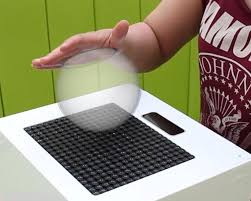
Our sense of touch is clearly more acute than many realize.
A new study demystifies the “unknown sense” with first-ever measurements of human tactile perception.
In a ground-breaking study, Swedish scientists have shown that people can detect nano-scale wrinkles while running their fingers upon a seemingly smooth surface. The findings could lead such advances as touch screens for the visually impaired and other products, says one of the researchers from KTH Royal Institute of Technology.
The study marks the first time that scientists have quantified how people feel, in terms of a physical property. One of the authors, Mark Rutland, Professor of Surface Chemistry, says that the human finger can discriminate between surfaces patterned with ridges as small as 13 nanometres in amplitude and non-patterned surfaces.
“This means that, if your finger was the size of the Earth, you could feel the difference between houses from cars,” Rutland says. “That is one of the most enjoyable aspects of this research. We discovered that a human being can feel a bump corresponding to the size of a very large molecule.”
The research team consisted of Rutland and KTH PhD student Lisa Skedung, and psychologist Birgitta Berglund and PhD student Martin Arvidsson from Stockholm University. Their paper, Feeling Small: Exploring the Tactile Perception Limits, was published on September 12 in Scientific Reports. The research was financed by a grant from Vinnova and the Knowledge Foundation to the SP Technical Research Institute of Sweden. Rutland says that the project will pursue applications of the research together with SP.
The study highlights the importance of surface friction and wrinkle wavelength, or wrinkle width – in the tactile perception of fine textures.
When a finger is drawn over a surface, vibrations occur in the finger. People feel these vibrations differently on different structures. The friction properties of the surface control how hard we press on the surface as we explore it. A high friction surface requires us to press less to achieve the optimum friction force.
“This is the breakthrough that allows us to design how things feel and are perceived,” he says. “It allows, for example, for a certain portion of a touch screen on a smartphone to be designed to feel differently by vibration.”
The research could inform the development of the sense of touch in robotics and virtual reality. A plastic touch screen surface could be made to feel like another material, such as fabric or wood, for example. The findings also enable differentiation in product packaging, or in the products themselves. A shampoo, for example, can be designed to change the feel of one’s hair.
The Latest Bing News on:
Human tactile perception
- The Best Nespresso Pods You Can Buy at the Grocery Storeon April 30, 2024 at 1:02 pm
When you buy through our links, we may earn a commission. Learn more› By Ciara Murray Jordan Ciara Murray Jordan is a writer covering kitchen gear. She has meticulously tested a range of things, from ...
- General-purpose humanoid is faster on the uptake, works for longeron April 26, 2024 at 6:04 am
The rapid progress of humanoid robot development is nothing short of astounding. Less than 12 months after introducing its 6th-gen general-purpose humanoid, Canada's Sanctuary AI has pulled back the ...
- Sanctuary AI Unveils its Next Generation of AI Roboticson April 25, 2024 at 2:38 pm
Sanctuary AI, a company on a mission to create the world's first human-like intelligence in general purpose robots, unveiled the seventh generation of its general purpose robot Phoenix. The latest ...
- Sanctuary AI reveals seventh-generation robot it calls “analogous to a person”on April 25, 2024 at 12:11 pm
Vancouver-based robotics startup Sanctuary AI has revealed the seventh generation of its general-purpose robot, Phoenix.
- Sanctuary AI Unveils the Next Generation of AI Roboticson April 25, 2024 at 2:00 am
Generation 7 of 'Phoenix' robots include improved human-like range of motion Improvements in uptime, visual perception, and tactile sensing increase the capability of the system to perform complex ...
- Maintaining internal representations: the role of the human superior parietal lobeon April 21, 2024 at 5:00 pm
However, to the best of our knowledge, there are no reports of patients in whom perception of tactile stimuli fades ... over the same time course in a human subject with a parietal lesion.
- Touchibo, a robot that fosters inclusion in education through touchon April 5, 2024 at 9:05 am
Their most recent study showed improved individual and group participation perception ... exploring the power of tactile interactions. "Touchibo aims to bridge the gap between children with ...
- Soft Magnetoelectric Finger: Enhancing Robotic Tactile Perceptionon January 10, 2024 at 9:29 am
The SMF is inspired by the tactile perception mechanism of the human finger, which involves the generation and transmission of nervous impulses by the tactile receptors in the fingertip skin.
- ELEC_ENG 431: Human Perception and Electronic Mediaon June 17, 2019 at 2:23 am
Fundamentals of visual, acoustic, and tactile perception; display devices; perceptual models for image, video, acoustic, and tactile signal analysis, compression, quality evaluation, and understanding ...
The Latest Google Headlines on:
Human tactile perception
[google_news title=”” keyword=”Human tactile perception” num_posts=”10″ blurb_length=”0″ show_thumb=”left”]
The Latest Bing News on:
Sense of touch
- Hadeda ibises' 'sixth sense' works best in wet soil: New research is a wake-up call for survival of wading birdson May 3, 2024 at 8:30 am
Hadeda ibises (Bostrychia hagedash) are one of the most familiar species of birds across sub-Saharan Africa. They are large, long-legged birds with long, thin beaks for probing invertebrates out of ...
- Hadeda Ibises' 'Sixth Sense' Works Best in Wet Soil - New Research Is a Wake-Up Call for Survival of Wading Birds With This Superpower [analysis]on May 3, 2024 at 6:10 am
Hadeda ibises (Bostrychia hagedash) are one of the most familiar species of birds across sub-Saharan Africa. They are large, long-legged birds with long, thin beaks for probing invertebrates out of ...
- Stretchable e-skin could give robots human-level touch sensitivityon May 2, 2024 at 5:00 pm
E-skin technology senses pressure from contact, letting the attached machine know how much force to use to, for example, grab a cup or touch a person. But, when conventional e-skin is stretched, it ...
- Leading The Era Of Sense And Response Marketingon May 1, 2024 at 4:30 am
Consumer behaviors are rapidly changing, and your strategies must adapt in order to prevent your brand from lagging behind the competition.
- JBL Soundgear Sense review: Great sound but features are lacking at the priceon April 30, 2024 at 10:01 pm
The Soundgear Sense are listed at $149 / £128 / AU$199, falling into a price range similar to many of the best bone-conduction headphones. They also carry a lower price than the Soundcore AeroFit Pro ...
- Met Gala 2024: How to Literally Touch and Smell Fashion Details at The Met Museum’s New Costume Institute Showon April 29, 2024 at 5:54 pm
Ahead of fashion’s upcoming, over-the-top night on May 6, curator Andrew Bolton talks about the ways his new show 'Sleeping Beauties' engages all the senses.
- Wonders Of Feelings And The Senseson April 27, 2024 at 11:33 pm
On the Internet I recently found something that piqued my interest. On a site called the “Power of Positivity” it listed the Seven Wonders of the World like this. “We can: see, hear, touch, taste, ...
- The Failure Of ‘Zoolander 2’ Broke Ben Stiller, Made Him Wonder If He Lost His Sense Of Humoron April 25, 2024 at 7:34 am
Sometimes, legacy sequels to beloved movies -- such as Creed or Top Gun: Maverick, to name a few -- wind up as massive successes. Other times, they wind ...
- 'I’ve fostered over 70 children – you have to keep a sense of humour'on April 24, 2024 at 3:47 am
A 'supermum' who fostered more than 70 kids says her tops tips for raising teenagers include not judging them and keeping a sense of humour. Norma Shaw, 83, says over 38 years of fostering she ...
- A multimodal approach to polysemy: the senses of touchon April 23, 2024 at 1:18 pm
Many of the senses of a polysemous word ... s arm with her left hand to illustrate and emphasize the fact that the naughty child dared to touch her. In this clip, Halle Berry explains how she got ...
The Latest Google Headlines on:
Sense of touch
[google_news title=”” keyword=”sense of touch” num_posts=”10″ blurb_length=”0″ show_thumb=”left”]










